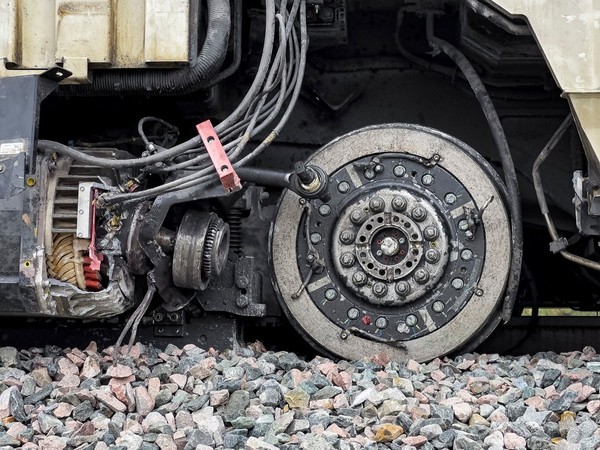Explainer: Beware the bogie man — What you need to know about LRT wheels
A report about efforts to find long-term solutions to wheel-related problems is to be delivered this week to a special joint meeting of the City of Ottawa's transit commission and the LRT sub-committee.
Blair Crawford, Ottawa Citizen
Published May 28, 2024 • Last updated 1 hour ago • 4 minute read

It’s been nearly three years since a faulty wheel caused the derailment of a Confederation Line train just outside Tunney’s Pasture Station, but a permanent fix to the problem remains frustratingly elusive.
Greasing the track, grinding the rails, reducing speed limits on curves, even installing extra pins to better secure train wheels are among the short-term fixes being used by Rideau Transit Group to ease stresses on each train’s cartridge bearing assembly (CBA), a crucial component of the wheels.
“These mitigations, however, do not resolve the outstanding lack of consensus on root cause of the CBA failures,” says a report to be delivered this week to a special joint meeting of the City of Ottawa’s transit commission and the LRT sub-committee.
“It is imperative that RTG works with its track and vehicle teams to reach agreement on the corrective action plan that will ensure the sustainability of the railway.”
The Problem
Who can forget 2021, the Confederation Line’s summer of woe?
On Aug. 8, an eastbound O-Train derailed about 90 metres of east of Tunney’s Pasture Station. There were no passengers onboard and no injuries, but it took three days to move the crippled train back to the RTG maintenance facility for inspection. A Transportation Safety Board report determined a wheel on the train had “severed from the axle due to an undetected catastrophic roller bearing failure and subsequent axle journal burn-off.”
The LRT was out of service for more than five weeks while workers inspected every train in the fleet, finding and replacing three more faulty axles.
A few weeks later, on Sept. 19, there was another derailment, this time near Tremblay Station and with passengers aboard. A westbound train went off the rails and tore up 400 metres of track, shutting the system down for two months. That accident wasn’t caused by an axle failure, however, but was blamed on an improperly tightened bolt after an axle inspection.
And the gremlins weren’t done yet. In July 2022, an alert driver was leaving Tunney’s Pasture Station when he noticed an unusual vibration and stopped the train. The cause was later found to be another failure inside the cartridge bearing assembly.
In July 2023, service was suspended again after a routine inspection found leaking grease on one train that was traced back to a failed bearing.
Each of the Alstom Citadis Spirit trains on the Confederation Line has 20 wheels: four wheels to each of five bogies. Each bogie, in turn, has two cartridge bearing assemblies, complex units that house bearings and a splined axle for each wheel. The CBAs were designed to have a life of 1.2 million kilometres of use.
The Studies
A myriad of reports have tried to identify the problem and to find short-, medium- and long-term solutions.
Among them were a Rail Safety Advisory letter from the Transportation Safety Board, an independent inspection of the track by MxV Rail, ongoing studies by the National Research Council, an independent report by the engineering firm James Boyle and Associates as well as investigations by the city, RTG and trainmaker Alstom, the latter of which is being independently reviewed for the city by the Mott MacDonald engineering firm.
The fixes
Inspections: RTG has stepped up inspections of the bogies, first to every 7,500 kilometres of use, later reduced to every 3,750 kilometres. Additionally, leading and trailing bogies — the ones that endure the highest stresses — were replaced, first every 175,000 kilometres and eventually every 60,000 kilometres.
Speed reductions: The Confederation Line has a number of curves that place higher than expected stress on train wheels. To reduce those, the train operates with temporary speed reductions (TSRs) along several sections, notably east of the Rideau Centre and east of Hurdman Station. The TSRs remain in effect two years after they were imposed.
Restraining rail adjustments: The Confederation Line includes a third “restraining rail” along its curves that is meant as a safety feature to prevent derailments. These rails were found to be rubbing the wheels, increasing wear and tear, so in 2023 crews painstakingly shifted each one to provide more clearance.
Top rail lubricants: Greasing the tracks is more than just a cliché. RTG is installing “top of rail friction modifiers” along tracks to reduce the stress and vibration on the wheels. The above-ground units are to be installed by the end of May with work on the those in the tunnels to be completed this summer.
Nut pinning measures: Since train wheel vibrations have been blamed for loosening nuts within the wheel assemblies, maintenance crews have been installing simple pins to keep the nuts firmly in place.
Smart bugs: NRC-designed “smart bugs” use accelerometers to measure vibrations within the bearing assemblies and to warn when something goes wrong. If they work, the devices could be installed on all trains.
Rail grinding: Like all tracks, the Confederation Line rails need periodic regrinding to maintain their shape. That work will be done in October during a partial shutdown for maintenance.
The long-term solution
A complete wheel assembly redesign: There’s the rub. RTG is committed to providing a complete redesign of the cartridge bearing assembly, one that will strengthen it and “better withstand the lateral forces experienced on the Confederation Line and deliver a product that meets reliability, availability, maintainability, and safety requirements,” the city report says.
Alstom, however, disagrees. “Alstom has indicated that a Sustainable Solution can be achieved without a redesign and is not currently working on this initiative,” the report says. “The city has formally communicated the imperative for the re-design work to re-commence.”
https://ottawacitizen.com/news/local...out-lrt-wheels



